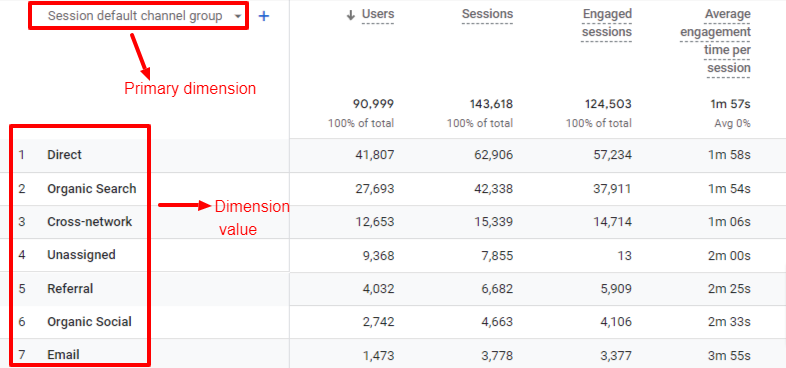Secondary Dimension in Google Analytics: Best Practices and Tips
Transform Your Analytics Approach With Second Measurement in Google Analytics
By incorporating secondary measurements into information analysis, a brand-new layer of understandings emerges, losing light on elaborate customer habits and communications. The calculated application of secondary measurements holds the key to unlocking a prize chest of vital information that can revolutionize how organizations act and translate upon their information.
Understanding Additional Measurements in Google Analytics
Secondary measurements in Google Analytics provide extra context to key data by permitting users to evaluate metrics throughout a second dimension, supplying deeper insights right into customer habits and communications on a website. Secondary Dimension in Google Analytics. While main measurements provide essential data points such as pageviews, bounce price, and session period, secondary measurements supply a more comprehensive sight by segmenting the key data additionally. This division enables customers to assess metrics in combination with another dimension, such as website traffic resources, demographics, or customer habits
Advantages of Making Use Of Secondary Dimensions
Using additional dimensions in Google Analytics offers a tactical benefit by improving the deepness of evaluation and giving an extra extensive understanding of individual interactions and habits on an internet site. By incorporating additional measurements, experts can get important insights into the performance of details sectors or variables within their data. This allows an extra thorough exam of user behavior beyond surface-level metrics, enabling for a deeper expedition of the aspects influencing customer involvement and conversions.

Just How to Implement Second Dimensions
When incorporating secondary measurements in Google Analytics, one necessary action is to choose the relevant metrics and measurements to enhance the analysis procedure. To implement additional dimensions successfully, start by accessing your Google Analytics account and browsing to the record you intend to improve with added information. As soon as in the record, find the "Second Measurement" button, generally found over the information table. Clicking on this switch will open up a drop-down food selection listing various measurements that can be included in your primary measurement for much deeper insights.
After picking the appropriate additional measurement, such as 'Source/Medium' or 'Tool Category,' Google Analytics will certainly present the data in a much more in-depth format, allowing you to cross-analyze different aspects of user actions. Remember to try out various combinations of key and additional dimensions to uncover important patterns and patterns that can educate your advertising methods. By implementing additional dimensions thoughtfully, you can acquire a much more detailed understanding of your web site or application performance and make data-driven choices to maximize your electronic presence.
Analyzing Information With Second Measurements
Boost your information analysis in Google Analytics by integrating additional dimensions to delve deeper into individual habits patterns and enhance your digital advertising techniques successfully - Secondary Dimension in Google Analytics. By adding additional dimensions to your main data, you can acquire important insights that can help you make informed choices regarding your site or application efficiency
Examining data with additional dimensions allows you to sector your main data further, giving a much more extensive sight of customer interactions. As an example, incorporating the main dimension of 'source/medium' with a second dimension like 'touchdown page' can disclose which particular web pages are driving web traffic from different resources. This information can be important in fine-tuning your content approach or enhancing your ad campaign to raise conversions.
Moreover, making use of second dimensions enables you to identify correlations between various metrics, helping you comprehend the effect of numerous variables on user behavior. Whether it's examining demographics along with user engagement metrics or tool classifications with conversion rates, additional dimensions encourage you to discover concealed fads and patterns that can guide your advertising initiatives.
Optimizing Performance With Second Dimensions
To improve the efficiency of data analysis and decision-making click to read more in Google Analytics, integrating secondary measurements is vital to maximizing efficiency metrics and acquiring deeper insights into user actions patterns. By making use of second measurements, analysts can delve beyond surface-level data and reveal beneficial correlations that may otherwise go undetected. This optimization approach allows services to tailor their advertising initiatives more efficiently, determine areas for improvement in site usability, and enhance overall user experience.
Second measurements supply an even more comprehensive sight of user communications by providing added context to main data metrics. Combining the primary dimension of 'touchdown web page' with a secondary dimension like Visit Your URL 'tool category' can expose whether specific devices are more most likely to drive interaction on particular landing web pages. This insight can notify receptive design enhancements or targeted advertising approaches to increase efficiency.

Verdict
In verdict, the assimilation of second measurements in Google Analytics supplies organizations with a powerful device to enhance their analytics approach. Secondary Dimension in Google Analytics. By delving deeper right into individual actions and interactions, online marketers can reveal important understandings that can drive performance optimization and enhance the total individual experience. Leveraging second dimensions permits a much more thorough evaluation of information, resulting in even more informed decision-making and tailored advertising and marketing initiatives
Secondary dimensions in Google Analytics give additional context to main data by permitting customers to examine metrics throughout a second measurement, providing deeper understandings into individual habits and communications on a website. While primary measurements provide fundamental information factors such as pageviews, bounce price, and session period, second measurements use an even more thorough view by segmenting the key data even more.One of the essential benefits navigate to these guys of using second dimensions is the ability to uncover correlations and patterns that may not be instantly apparent when assessing data with key dimensions alone.When integrating secondary dimensions in Google Analytics, one essential action is to pick the pertinent metrics and measurements to enhance the analysis process. Pairing the primary measurement of 'touchdown web page' with a second measurement like 'tool category' can expose whether specific gadgets are more most likely to drive interaction on particular landing web pages.